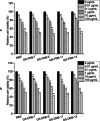Polysaccharides from Ganoderma Sinense - rice bran fermentation products and their anti-tumor activities on non-small-cell lung cancer
- PMID: 34112172
- PMCID: PMC8194173
- DOI: 10.1186/s12906-021-03346-7
Polysaccharides from Ganoderma Sinense - rice bran fermentation products and their anti-tumor activities on non-small-cell lung cancer
Abstract
Background: Non-small-cell lung cancer (NSCLC) accounts more than 80% of the lung cancer cases. Polysaccharides in rice bran and its fermentation products have been proven to suppress many cancers. However, the report on inhibiting NSCLC is few. In this paper, the polysaccharides with suppression activity to H1299 NSCLC in the fermentation products of full-fat rice bran and defatted rice bran were studied in vitro and in vivo.
Method: Polysaccharides (GSRBPs) were extracted from Ganoderma sinense - full-fat rice bran (GS-FRB) and Ganoderma sinense - defatted rice bran (GS-DRB) fermentation products. The structure information of the GSRBPs was studied using HPLC analysis. The anti-tumor activities on H1299 NSCLC of GSRBPs in vitro study was performed using MTT method. The in vivo studies use BALB/c-nu nude mice as H1299 NSCLC bearing mice.
Result: All the polysaccharides contained two fractions, GSFPS-1 and GSFPS-2. The molecular weight and the ratio of GSFPS-1 and GSFPS-2 were different in GS-FRB and GS-DRB. At the earlier state of fermentation, all polysaccharides were composed of D-glu, D-man, D-xyl and L-ara with certain molar ratios. But at the latter stage, polysaccharides in GS-FRB were composed of D-glu, D-man, D-xyl, L-ara and D-fru, while these in GS-DRB only composed of D-glu and D-man. In the in vitro study, the IC50 of RBS and GSRBPs was as GS-DRB-11 (40.62 μg/mL), GS-FRB-9 (43.82 μg/mL), GS-DRB-7 (48.08 μg/mL), RBS (49.56 μg/mL), GS-DRB-9 (49.91 μg/mL), GS-DRB-13 (51.89 μg/mL), GS-FRB-11 (53.75 μg/mL), GS-FRB-7 (56.84 μg/mL), GS-DRB-13 (60.63 μg/mL) from small to large. In the in vivo study, the H1299 NSCLC inhibition rate (InRa) of RBS and GSRBPs were GS-DRB-11 (86.81%) > GS-DRB-9 (86.01%) > GS-FRB-9 (84.88%) > GS-DRB-7 (82.21%) > GS-DRB-13 (78.04%) > RBS (76.06%) > GS-FRB-13 (65.44%) > GS-FRB-11 (64.70%) > GS-FRB-7 (27.87%). The GSFPS-2 area percent was negatively correlated to the IC50 and was positively correlated to the InRa. This means the GSFPS-2 had much higher anti-tumor activity than GSFPS-1.
Conclusion: GSFPS-2 had higher anti-tumor activities, and the lipid in the rice bran has a decisive effect on the structures of polysaccharides produced by fermentation. Therefore, GSRBPs could be considered as potential novel agents to suppress H1299 non-small-cell lung cancer.
Keywords: Anti-tumor activity; Ganoderma sinense fermentation; H1299 non-small-cell lung cancer; In vivo and in vitro; Rice bran polysaccharides.
Conflict of interest statement
The authors declare that they have no financial or non-financial competing interests with any organization or entity about the content of the manuscript.
Figures





Similar articles
-
Fermented rice bran supplementation mitigates metabolic syndrome in stroke-prone spontaneously hypertensive rats.BMC Complement Altern Med. 2016 Nov 8;16(1):442. doi: 10.1186/s12906-016-1427-z. BMC Complement Altern Med. 2016. PMID: 27821167 Free PMC article.
-
Fermentation of rice bran and defatted rice bran for butanol 5 production using clostridium beijerinckii NCIMB 8052.J Microbiol Biotechnol. 2009 May;19(5):482-90. doi: 10.4014/jmb.0804.275. J Microbiol Biotechnol. 2009. PMID: 19494696
-
Biphasic Fermentation of Trapa bispinosa Shells by Ganoderma sinense and Characterization of Its Polysaccharides and Alcoholic Extract and Analysis of Their Bioactivity.Molecules. 2024 Mar 11;29(6):1238. doi: 10.3390/molecules29061238. Molecules. 2024. PMID: 38542875 Free PMC article.
-
Production and Utilization of Fermented Rice Bran as Animal Feed.Anim Sci J. 2025 Jan-Dec;96(1):e70037. doi: 10.1111/asj.70037. Anim Sci J. 2025. PMID: 39947126 Free PMC article. Review.
-
The anti-cancer activity and potential clinical application of rice bran extracts and fermentation products.RSC Adv. 2019 Jun 10;9(31):18060-18069. doi: 10.1039/c9ra02439e. eCollection 2019 Jun 4. RSC Adv. 2019. PMID: 35520585 Free PMC article. Review.
Cited by
-
Emulating interactions between microorganisms and tumor microenvironment to develop cancer theranostics.Theranostics. 2022 Mar 14;12(6):2833-2859. doi: 10.7150/thno.70719. eCollection 2022. Theranostics. 2022. PMID: 35401838 Free PMC article. Review.
-
A Review of Ganoderma lucidum Polysaccharide: Preparations, Structures, Physicochemical Properties and Application.Foods. 2024 Aug 24;13(17):2665. doi: 10.3390/foods13172665. Foods. 2024. PMID: 39272434 Free PMC article. Review.
-
Liquid-Phase Adsorption Behavior of β-D-Glucooligosaccharides When Using Activated Carbon for Separation, and the Antioxidant Stress Activity of Purified Fractions.Foods. 2024 May 24;13(11):1634. doi: 10.3390/foods13111634. Foods. 2024. PMID: 38890863 Free PMC article.
-
Anti-Adipogenic Lanostane-Type Triterpenoids from the Edible and Medicinal Mushroom Ganoderma applanatum.J Fungi (Basel). 2022 Mar 22;8(4):331. doi: 10.3390/jof8040331. J Fungi (Basel). 2022. PMID: 35448561 Free PMC article.
-
Extraction, Structural Characterization, Biological Functions, and Application of Rice Bran Polysaccharides: A Review.Foods. 2023 Feb 2;12(3):639. doi: 10.3390/foods12030639. Foods. 2023. PMID: 36766168 Free PMC article. Review.
References
-
- Siegel RL, Miller KD, Jemal A. Cancer statistics, 2020. CA Cancer J Clin. 2020;60:235–244. - PubMed
-
- Naveed R, Humera K. The evolving role of histology in the treatment of non-small cell lung cancer. Med Health. 2010;93:317–319. - PubMed
-
- Guo W, Liu S, Ju X, Du J, Xu B, Yuan H, Qin F, Li L. The antitumor effect of hinesol, extract from Atractylodes lancea (Thunb.) DC. By proliferation, inhibition, and apoptosis induction via MEK/ERK and NF-κB pathway in non–small cell lung cancer cell lines A549 and NCI-H1299. J Cell Biochem. 2019;120(11):18600–18607. doi: 10.1002/jcb.28696. - DOI - PubMed
MeSH terms
Substances
Supplementary concepts
Grants and funding
- 2016YFD0400804/National Key Research and Development Program of China (CN)
- ZX 1939/Grant Fund for Basic Science, Research of Central Nonprofit Academe
- ZX 1940/Grant Fund for Basic Science, Research of Central Nonprofit Academe
- ZX 1941/Grant Fund for Basic Science, Research of Central Nonprofit Academe
LinkOut - more resources
Full Text Sources
Medical
Research Materials

